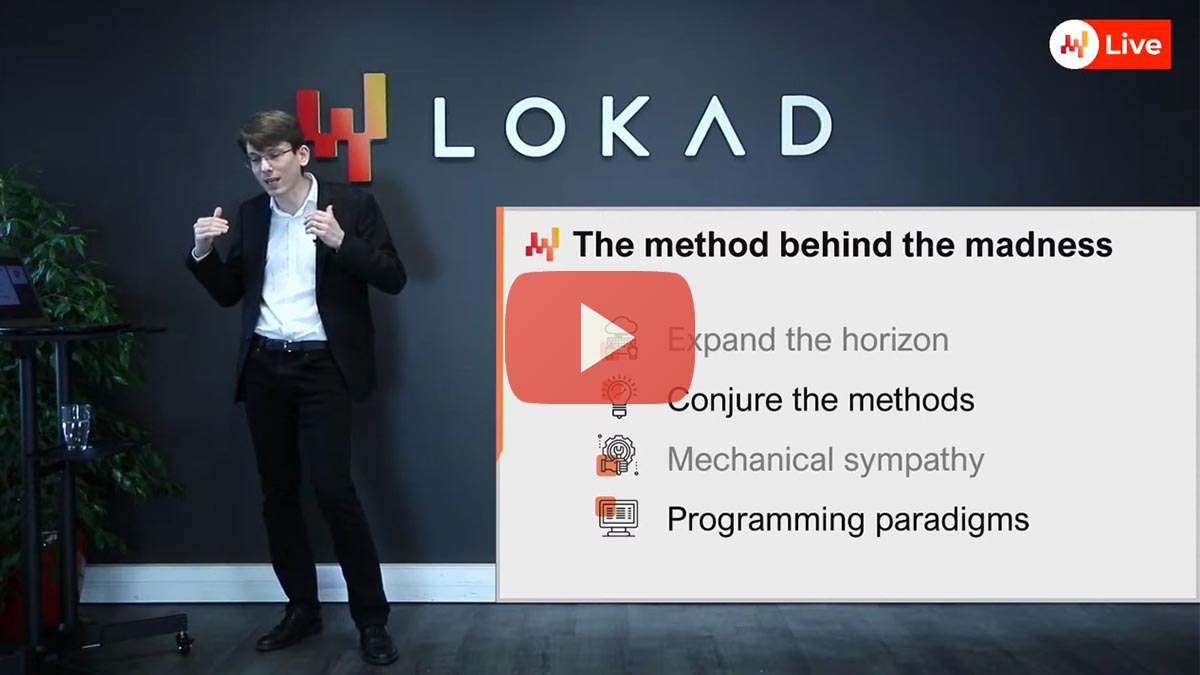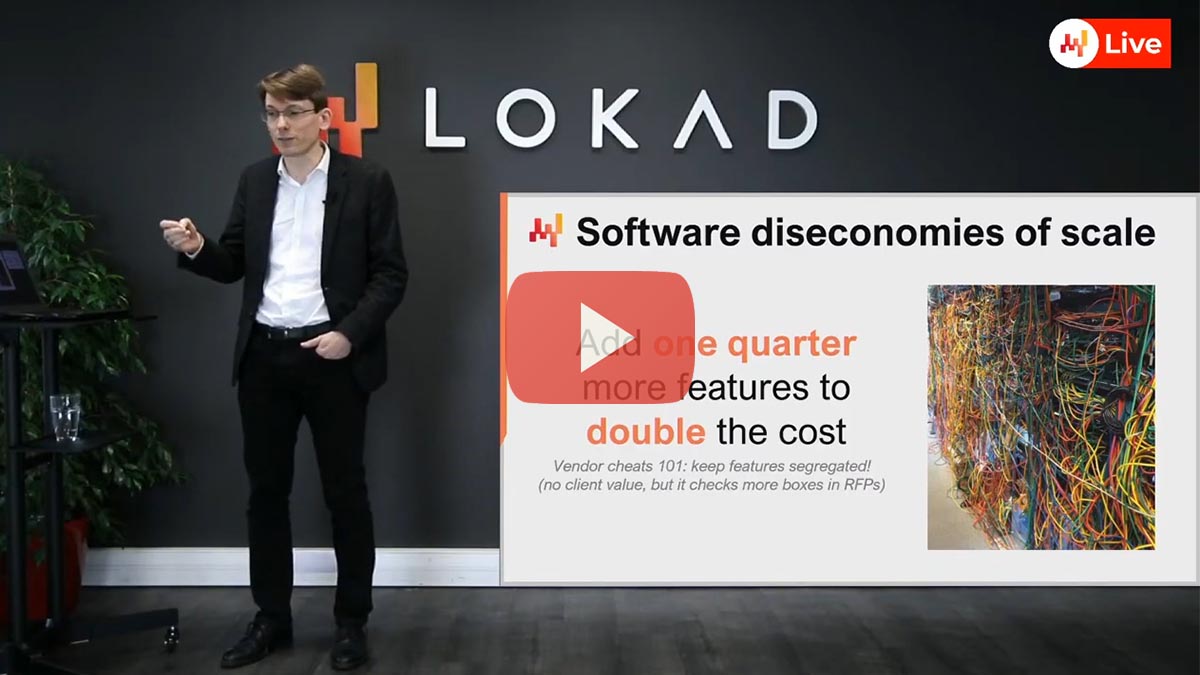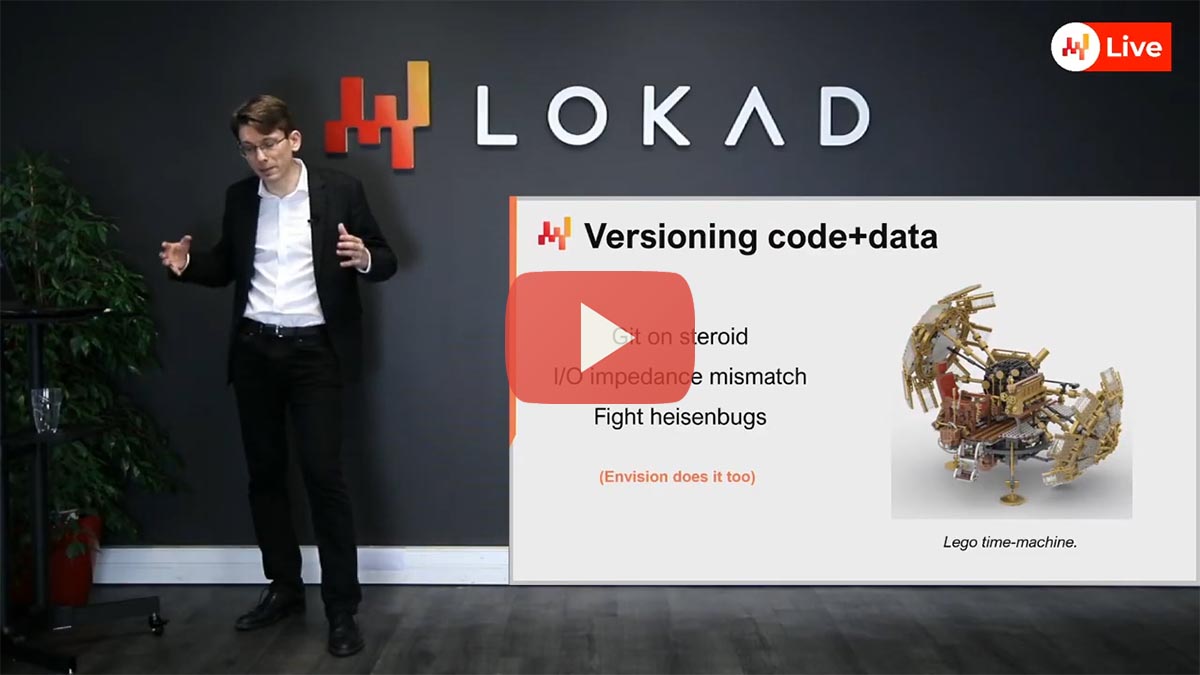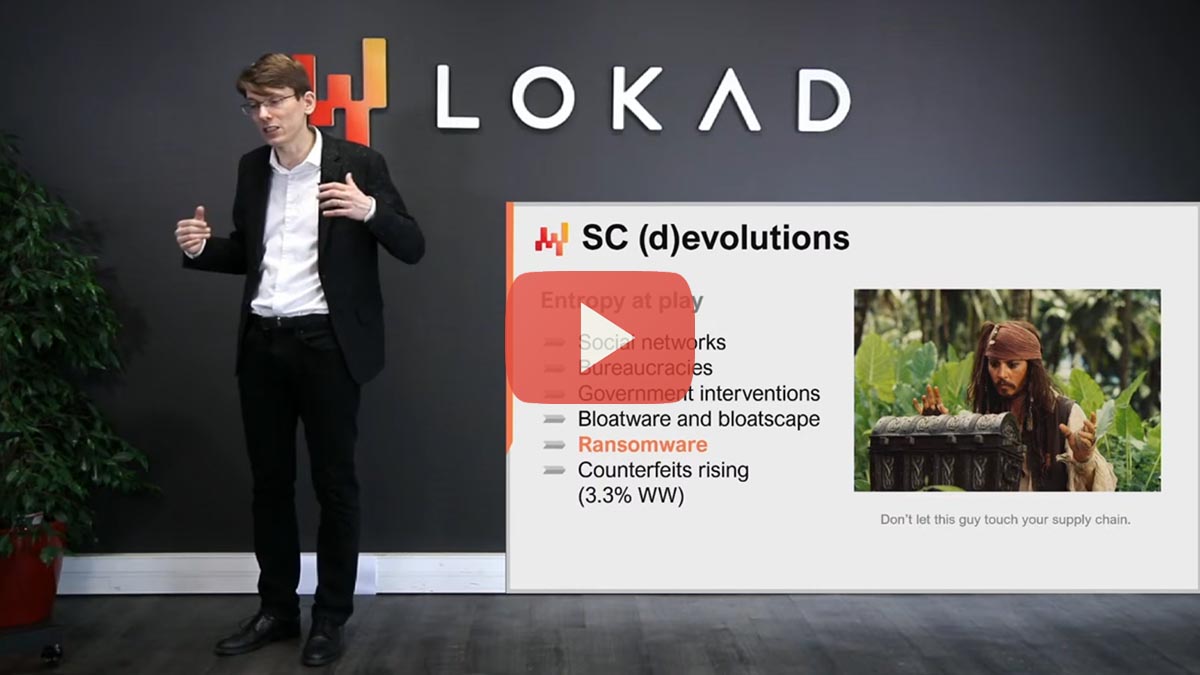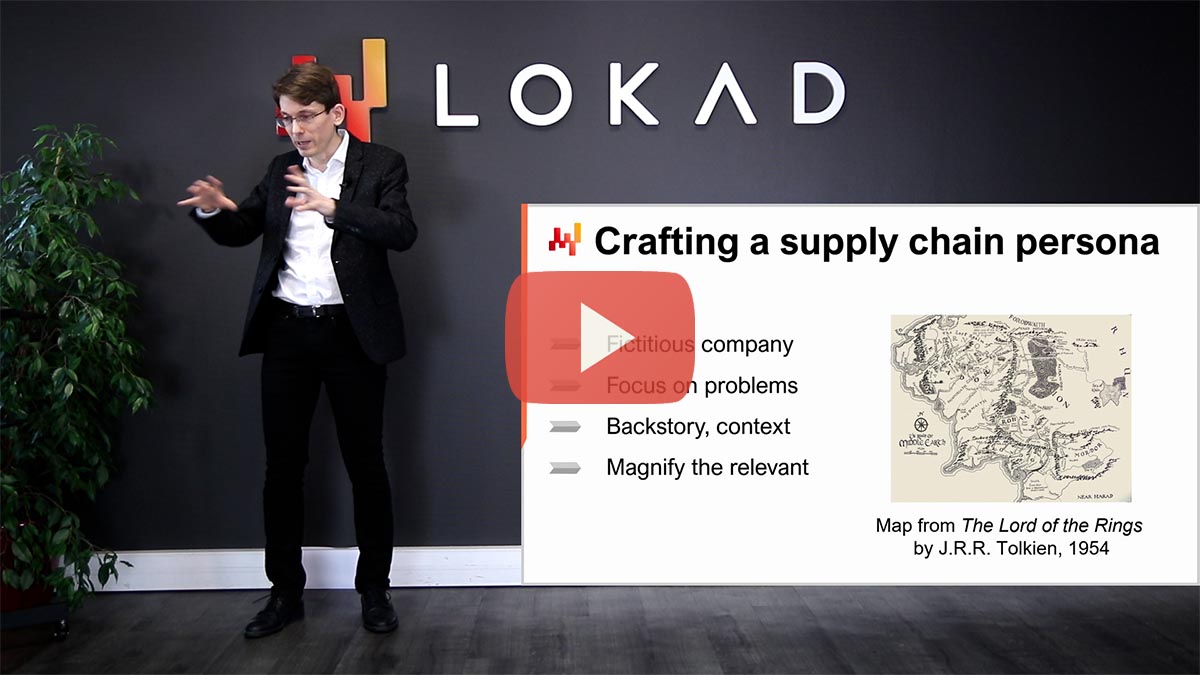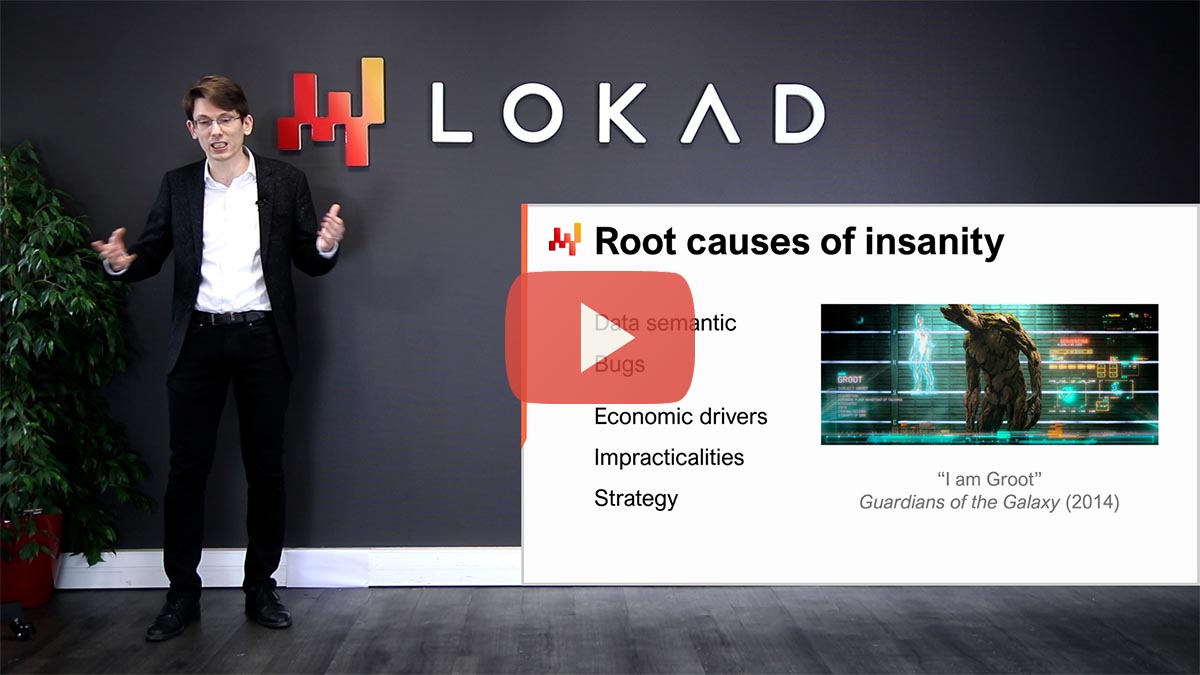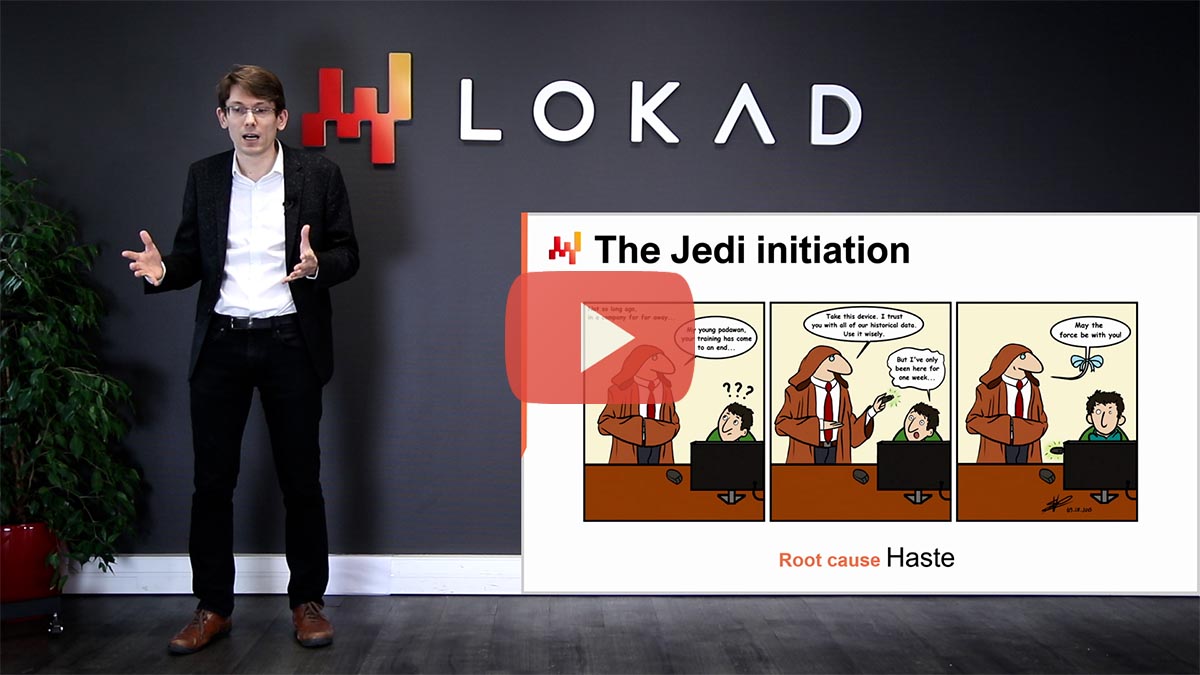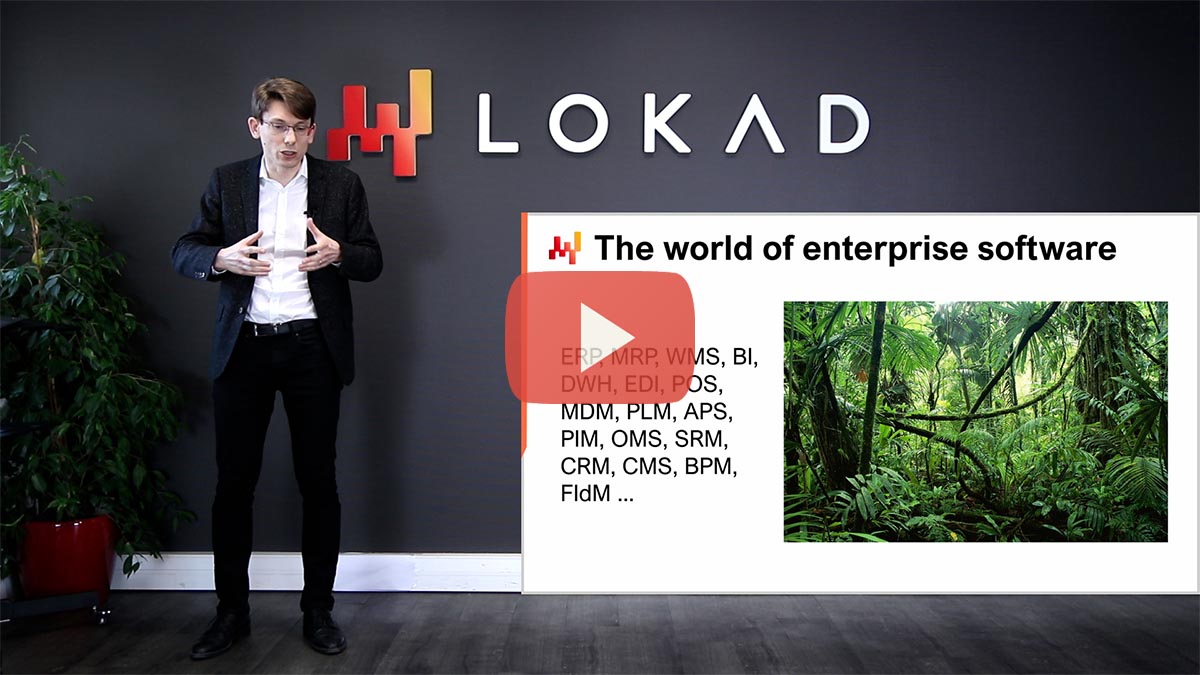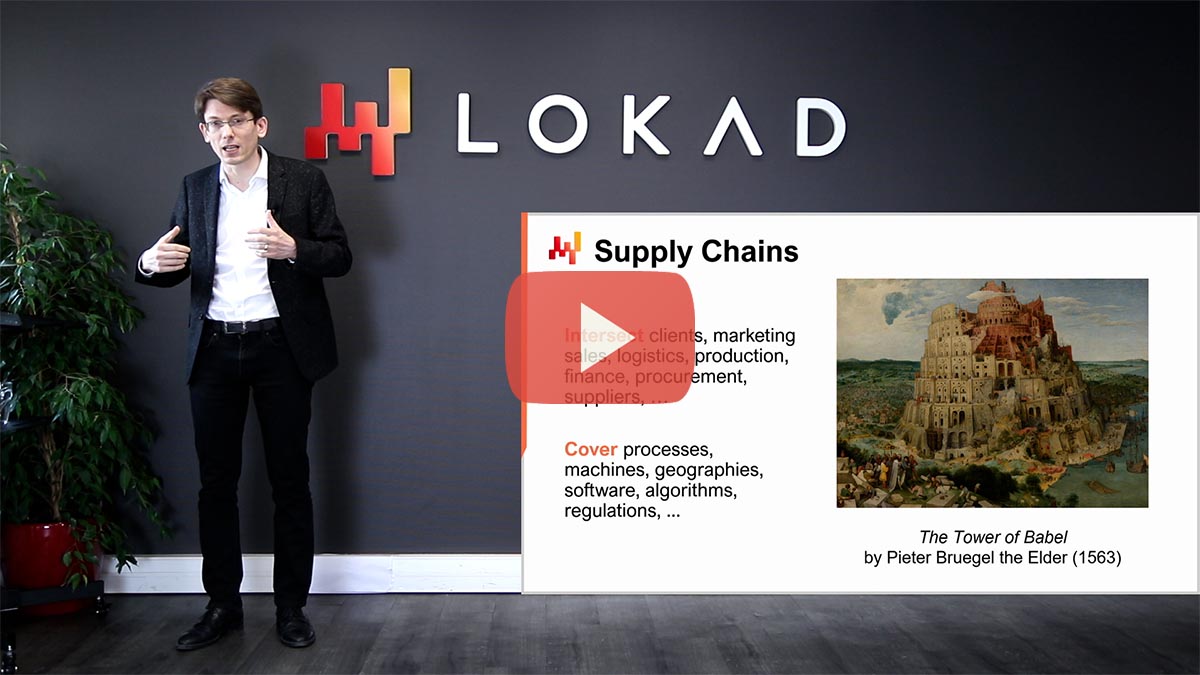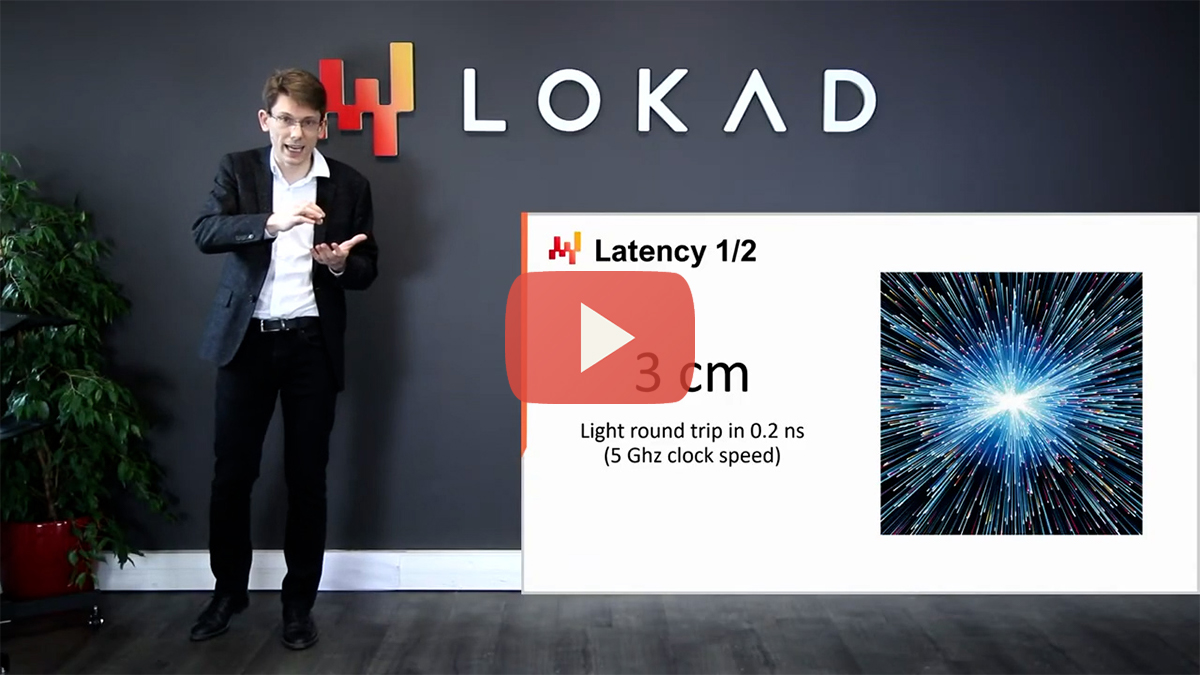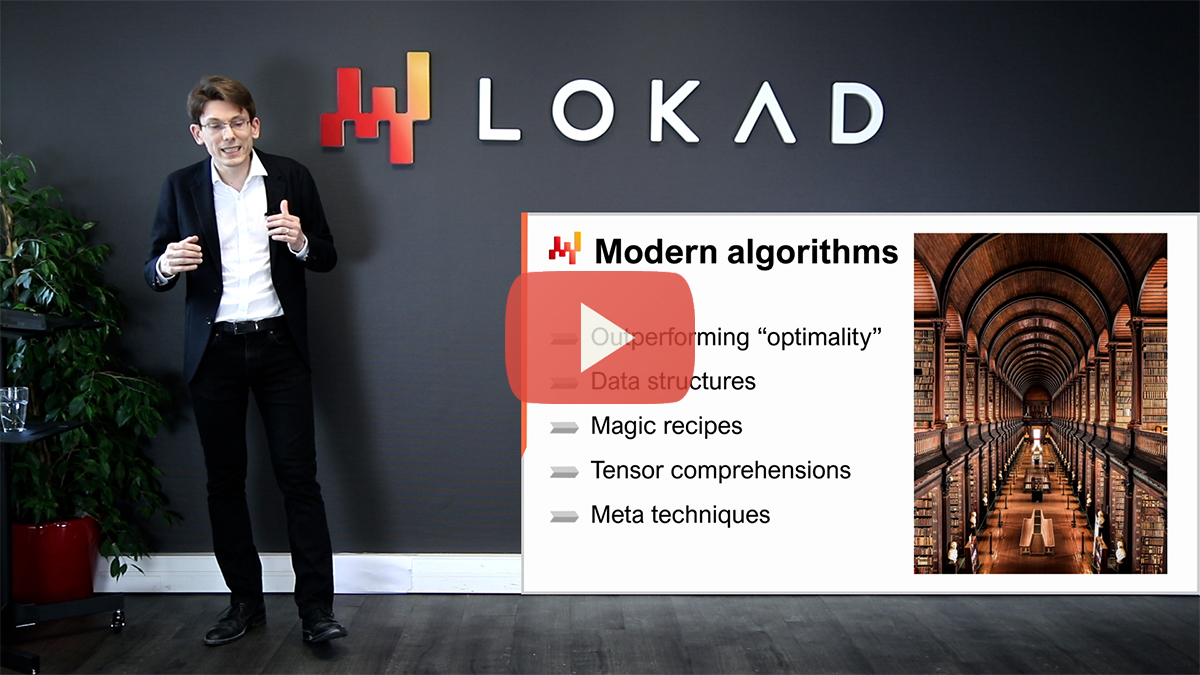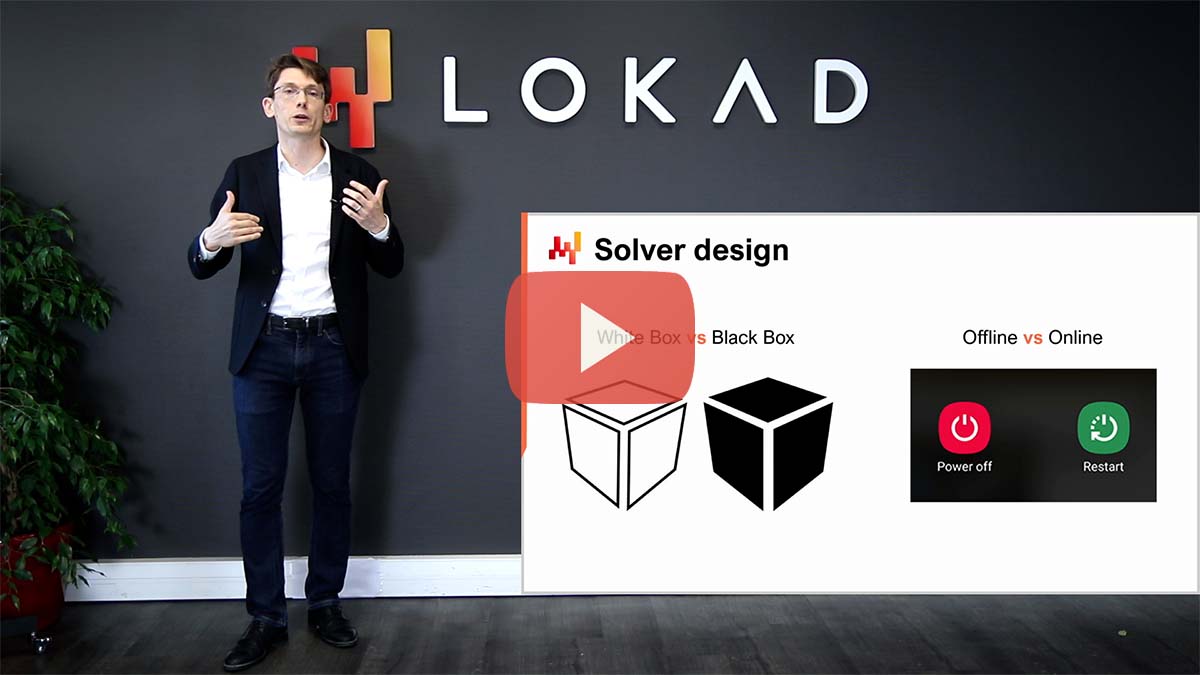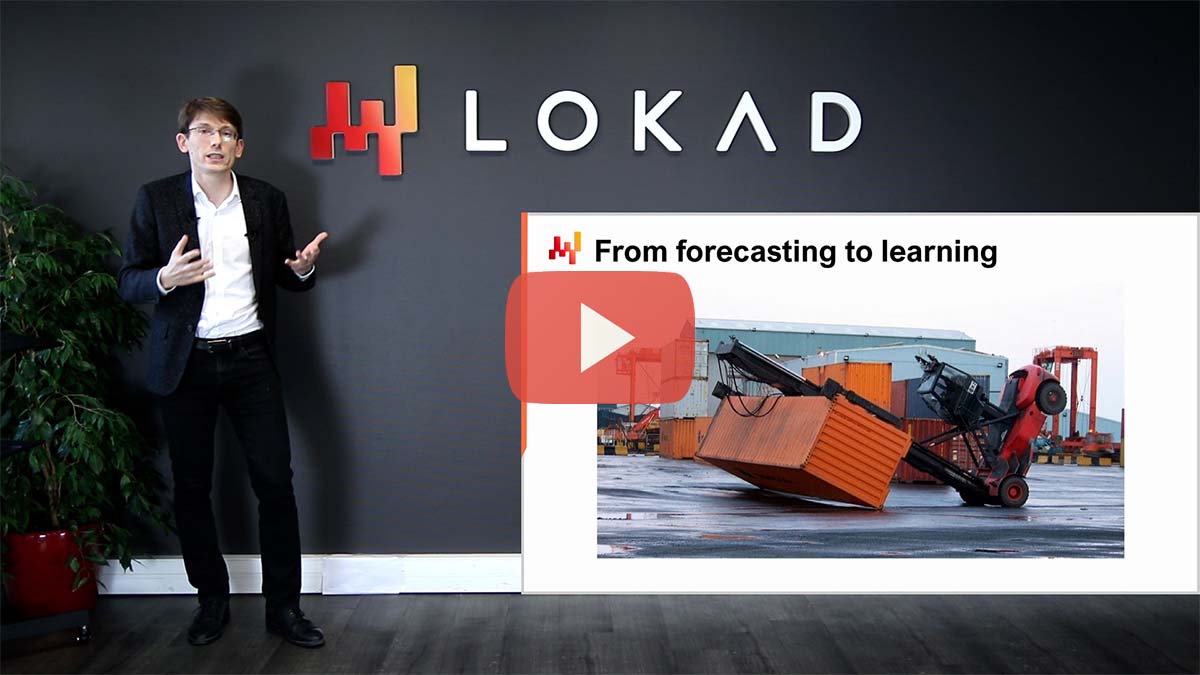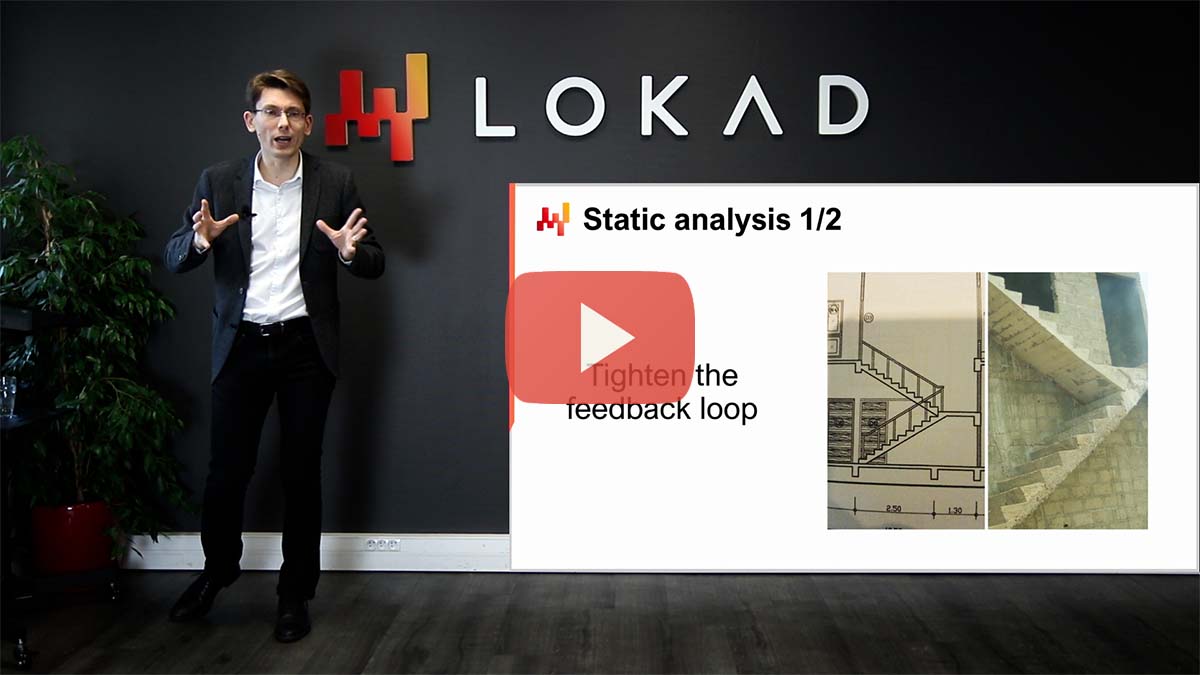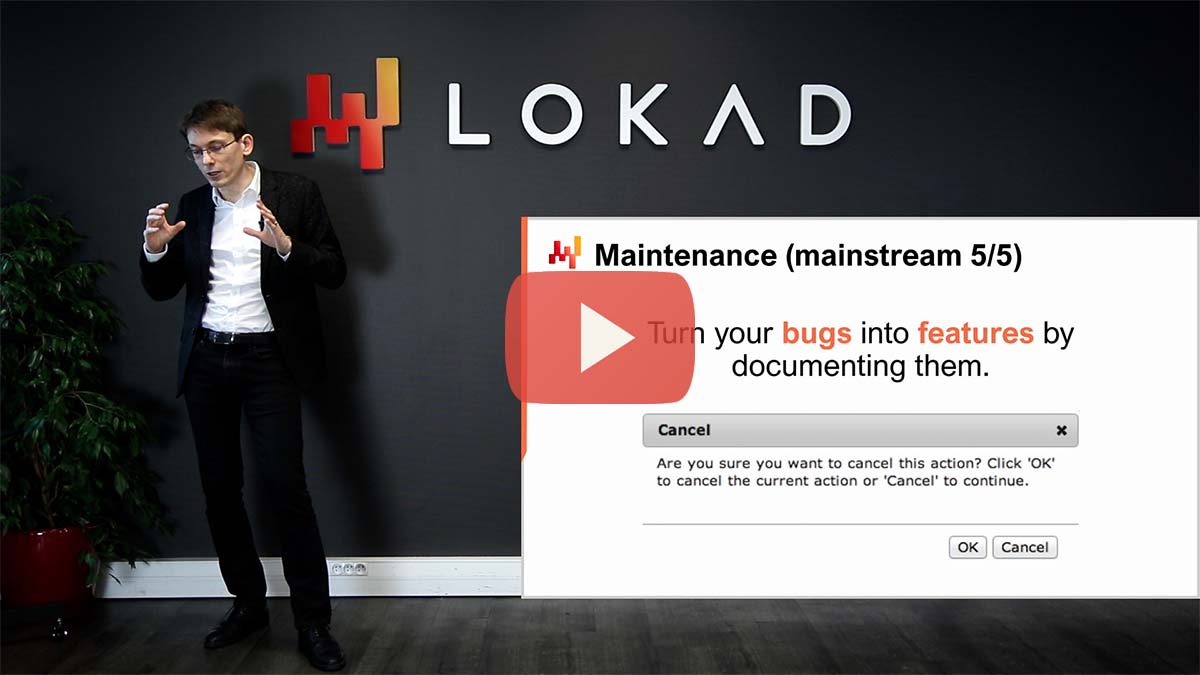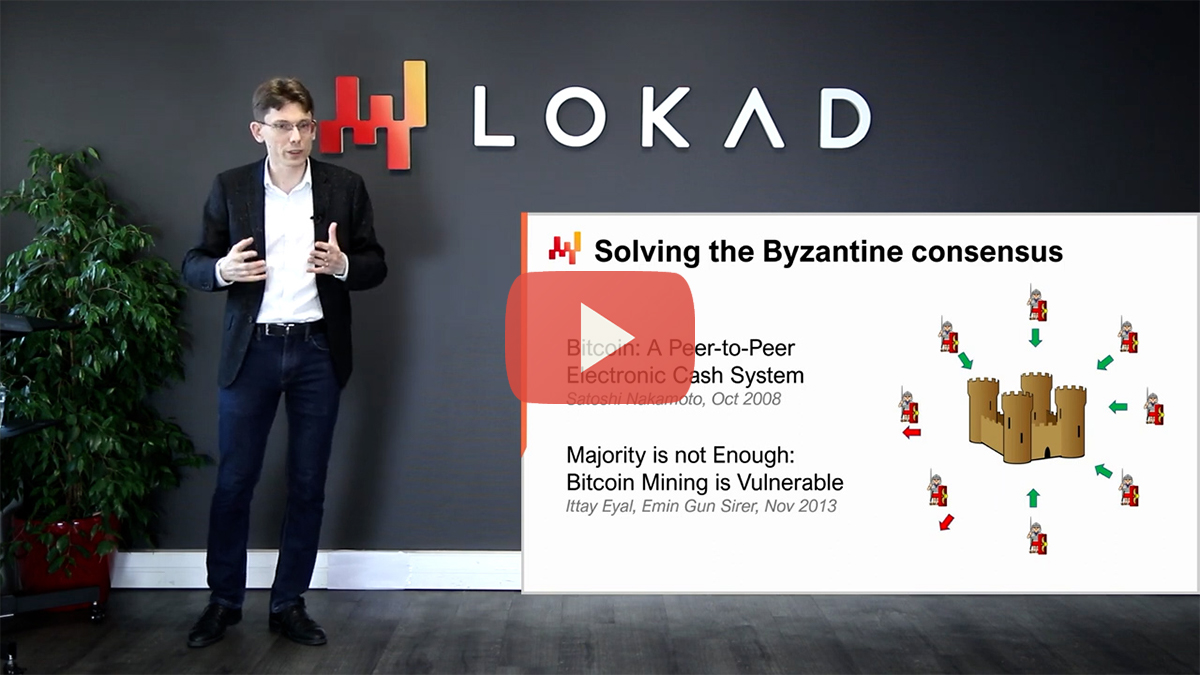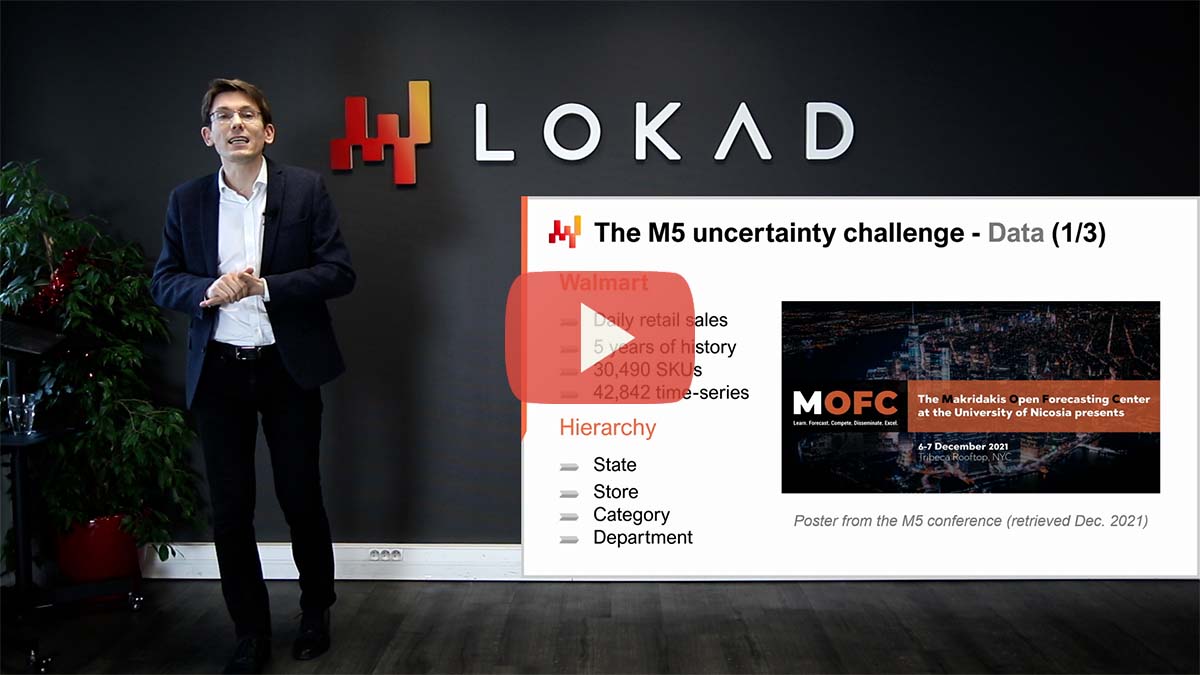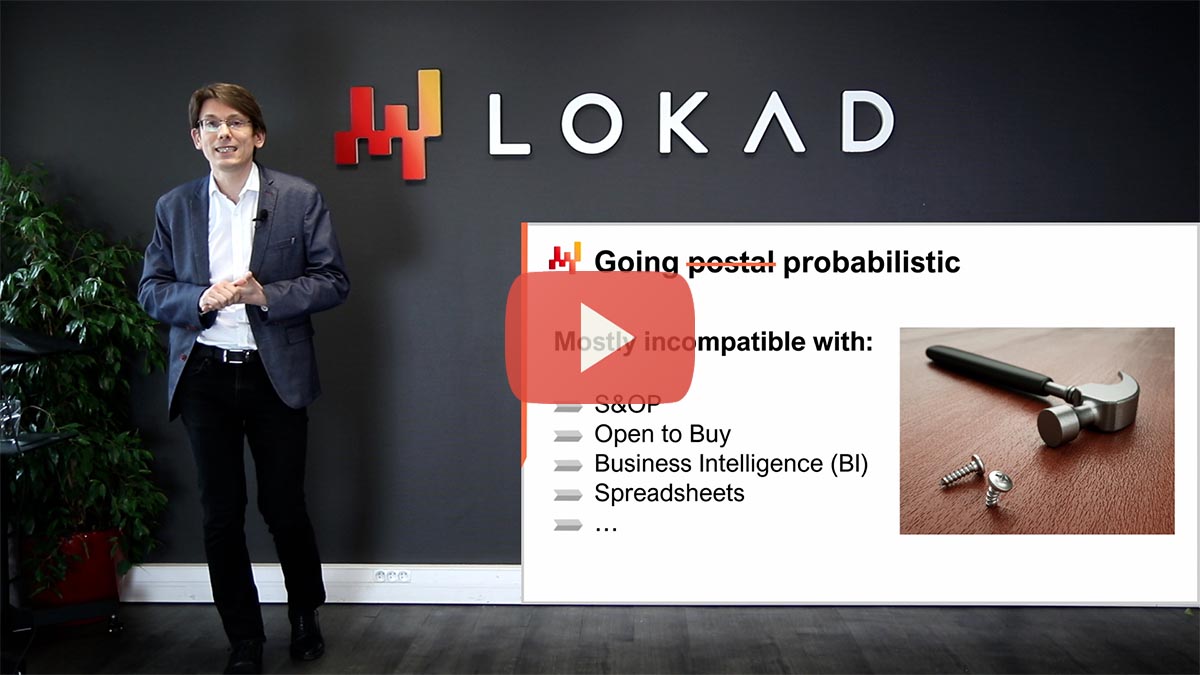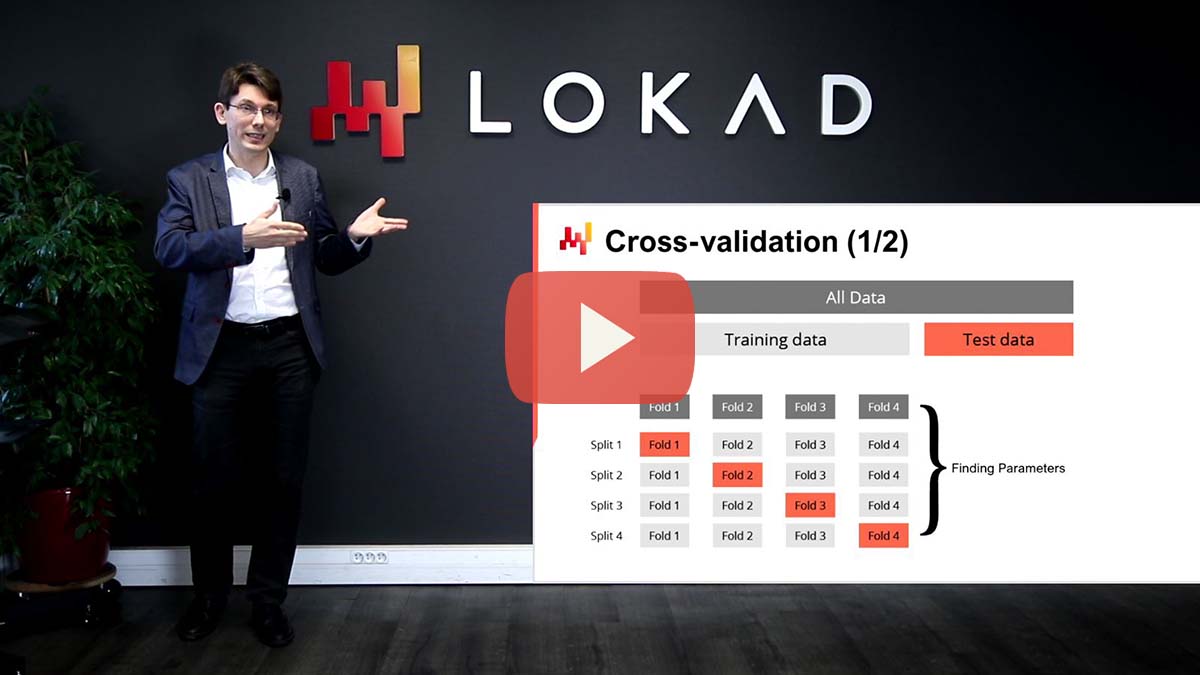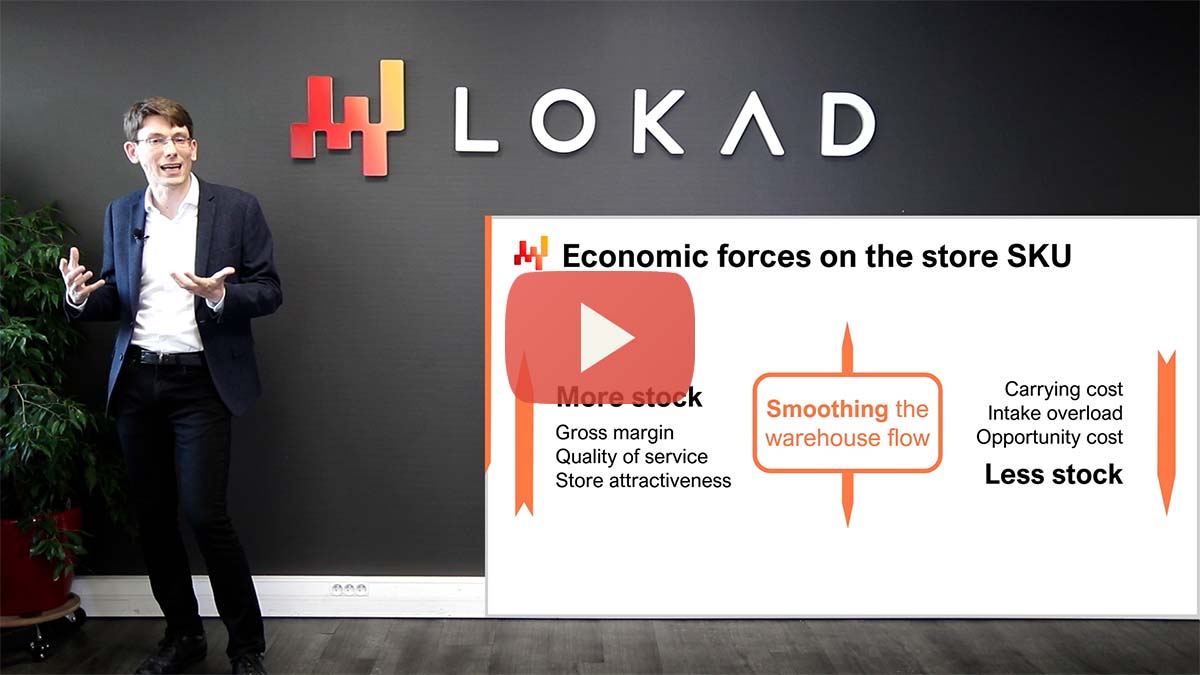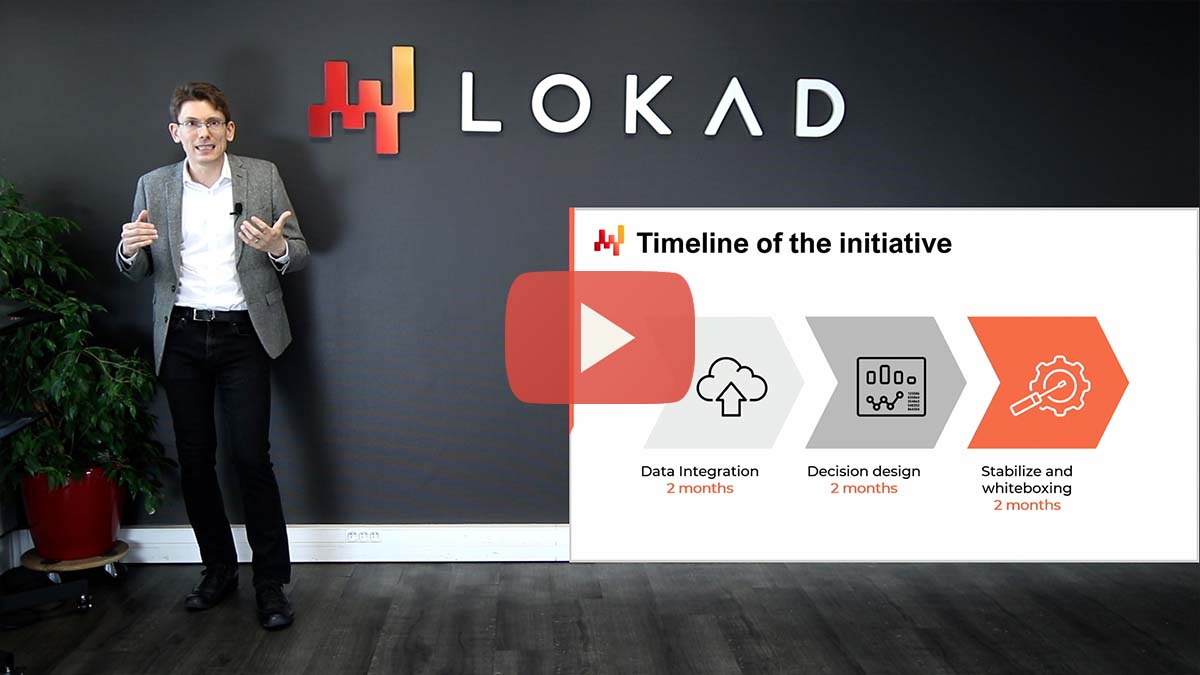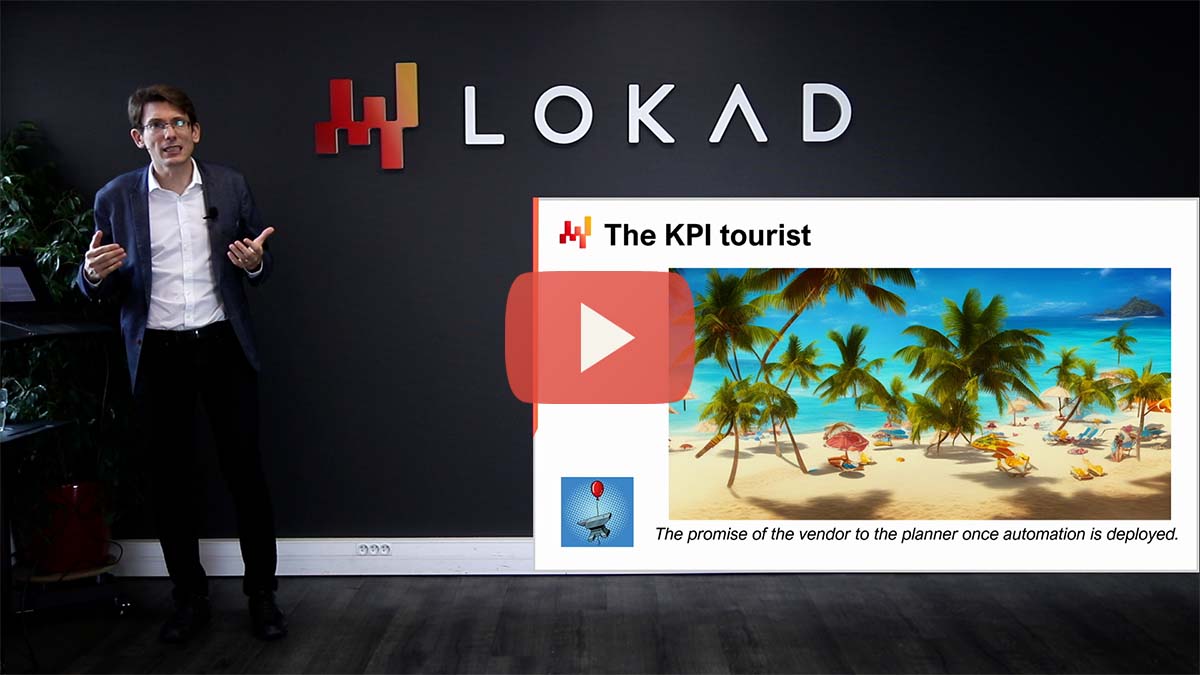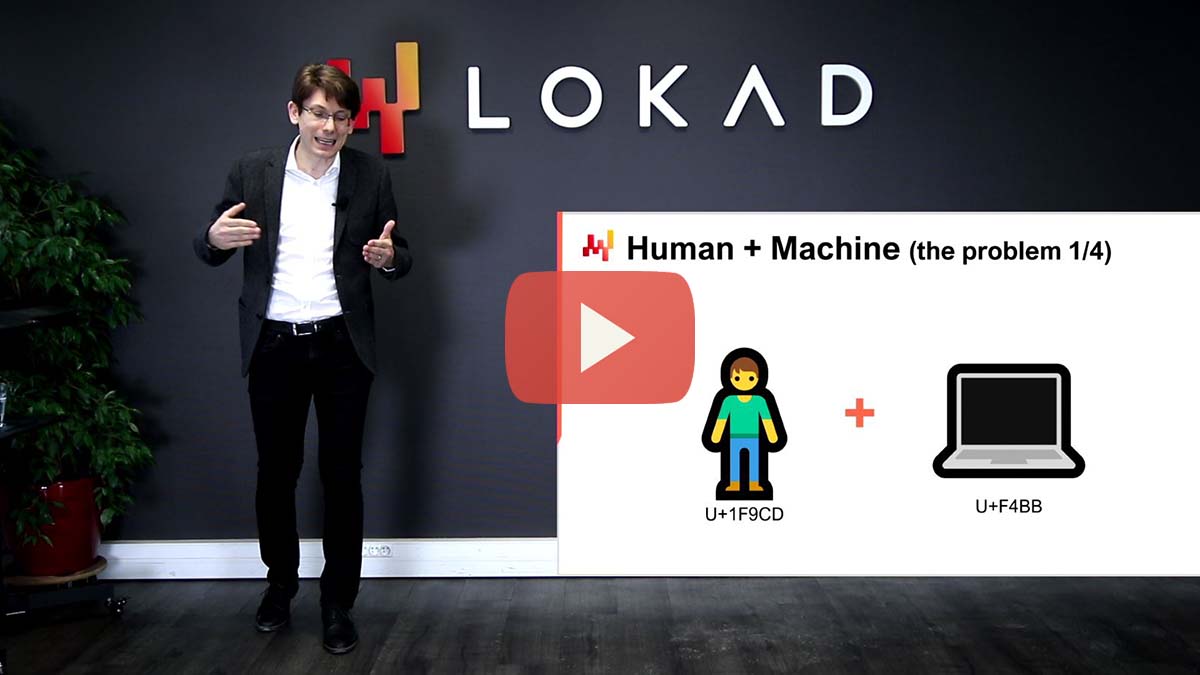Learn about Supply Chain
This ongoing series of lectures presents the foundations of supply chain management: the challenges, the methodology and the technologies. The intent is to allow organizations to achieve superior, ‘real-world’ supply chain performance. The vision presented in these lectures diverges from the mainstream supply chain theory, and is referred to as the quantitative supply chain. The lectures are presented by Joannes Vermorel, CEO and founder of Lokad. The lectures are illustrated with real-world supply chains that Lokad operates on behalf of its clients.
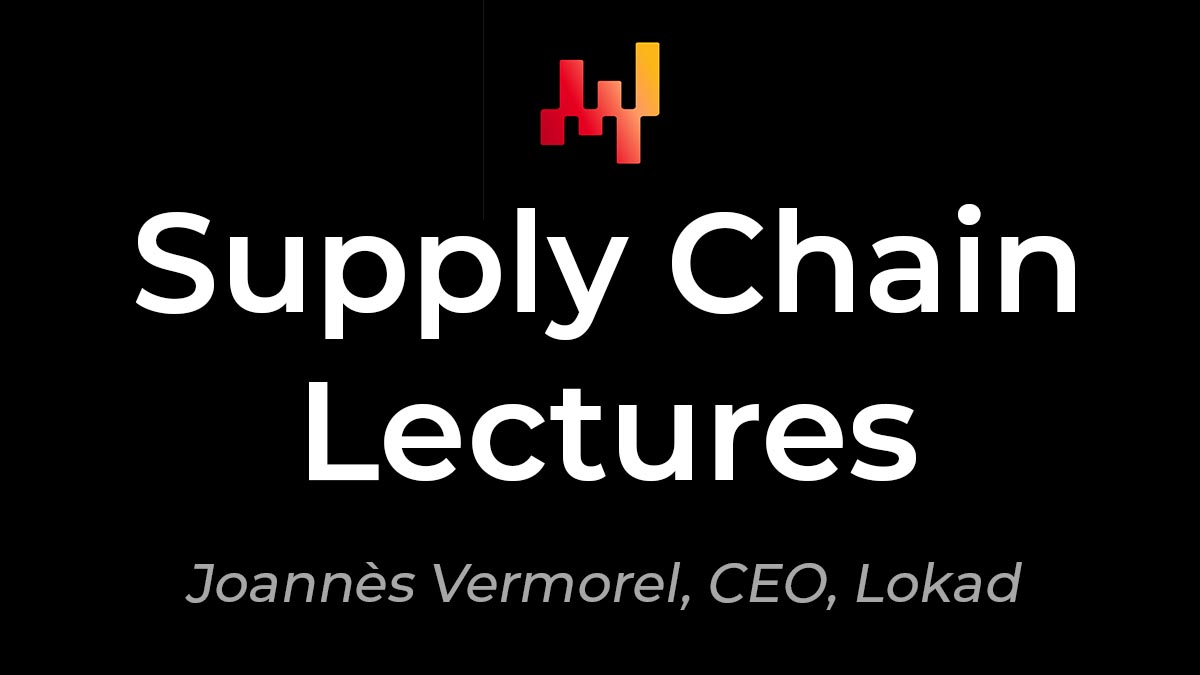
Intended audience: These lectures are intended to all those who have the ambition to improve supply chains, from senior executives to junior analysts and students. The lectures include a series of ‘crash courses’ to keep the prerequisite knowledge to a minimum.
1. Prologue
1.1 The foundations of supply chain
Supply chain is the quantitative yet street-smart mastery of optionality when facing variability and constraints related to the flow of physical goods. It encompasses sourcing, purchasing, production, transport, distribution, promotion, … - but with a focus on nurturing and picking options, as opposed to the direct management of the underlying operations. We will see how the “quantitative” supply chain perspective, presented in this series, profoundly diverges from what is considered the mainstream supply chain theory.
References (books):
- Inventory Management and Production Planning and Scheduling, Edward A. Silver, David F. Pyke, Rein Peterson, 1998
- Fundamentals of supply chain theory, Lawrence V. Snyder, Zuo-Jun Max Shen, 2011
1.2 The Quantitative Supply Chain in a nutshell
The manifesto of the quantitative supply chain emphasizes a short series of salient points to grasp how this alternative theory, proposed and pioneered by Lokad, diverges from the mainstream supply chain theory. It could be summarized with: every single decision is scored against all the possible futures according to the economic drivers. This perspective gradually emerged at Lokad as the mainstream supply chain theory, and its implementation by (nearly?) all software vendors, remains challenging.
1.3 Product-oriented delivery
The goal of a quantitative supply chain initiative is either to deliver or to improve a software application that robotizes a scope of routine decisions (e.g. inventory replenishments, price updates). The application is viewed as a product to be engineered. While mainstream supply chain theory struggles to prevail in companies at large, one tool “namely Microsoft Excel”, has enjoyed considerable operational success. Re-implementing the numerical recipes of the mainstream supply chain theory via spreadsheets is trivial, yet, this is not what happened in practice despite awareness of the theory. We demonstrate that spreadsheets won by adopting programming paradigms that proved superior to deliver supply chain results.
Reference (book):
- Joel on Software: And on Diverse and Occasionally Related Matters That Will Prove of Interest to Software Developers, Designers, and Managers, and to Those Who, Whether by Good Fortune or Ill Luck, Work with Them in Some Capacity, Joel Spolsky, 2004
1.4 Programming Paradigms for the Supply Chain
The predictive optimization of supply chains requires specific programming paradigms. Indeed, while the ‘programmatic’ angle cannot be avoided through a packaged software product (cf. previous lecture), mainstream programming approaches involve layers of accidental complexities which are severely detrimental to supply chain initiatives. We present a series of programming paradigms that are particularly well suited for real-world supply chains. This lecture is illustrated with Envision, the DSL (Domain-Specific programming Language) dedicated to the optimization of supply chains, engineered by Lokad based on those programming paradigms.
Reference (book, mentioned in the Q&A part of the lecture):
- Dynamic Supply Chains: How to design, build and manage people-centric value networks, John Gattorna, 2015
1.5 XXIst century trends in supply chain
A few major trends have been dominating the evolution of supply chains over the last decades, largely reshaping the mix of challenges faced by companies. Some problems have largely faded away, such as physical hazards and quality issues. Some problems have risen, such as overall complexity and competition intensity. Notably, software is also reshaping supply chains in profound ways. A quick survey of these trends helps us understand what should be the focus of a supply chain theory.
Reference (paper, mentioned in the Q&A part of the lecture):
- Tokeda, Viable token-driven metadata within Bitcoin, Joannes Vermorel, 2018, (blockchain use case to fight counterfeits on page 28)
1.6 Quantitative principles for supply chains
While supply chains can’t be characterized by definitive quantitative laws - unlike electromagnetism - general quantitative principles can still be observed. By “general”, we mean applicable to (almost) all supply chains. Uncovering such principles is of prime interest because they can be used to facilitate the engineering of numerical recipes intended for the predictive optimization of supply chains, but they can also be used to make those numerical recipes more powerful overall. We review two short lists of principles: a few observational principles and a few optimization principles
1.7 On Knowledge, Time and Work for Supply Chains
Supply chains abide by the general economic principles. Yet, these principles are too little known and too frequently misrepresented. Popular supply chain practices and their theories often contradict what is generally agreed upon in economics. However, these practices are unlikely to ever prove basic economics to be wrong. Additionally, supply chains are complex. They are systems, a relatively modern concept that is also too little known and too frequently misrepresented. The goal of this lecture is to understand what both economics and systems bring to the table when tackling planning problems for a real-world supply chain.
2. Methodology
The study and practice of supply chain must be rooted in science, that is to say, supported by scientific methods. Indeed, during the last three centuries, every single field that has managed to elevate itself via a suitable, experimental practice has undergone the fantastic progress that we have come to recognize as being the hallmark of ‘science’. However, supply chain has not experienced such progress, at least not yet, and much of the blame can be placed on improper experimental methodologies. Supply chain’s wicked nature demands suitable methods, which we explore in this chapter.
2.1 Supply Chain Personae
A supply chain “persona” is a fictitious company. Yet, while the company is fictive, this fiction is engineered to outline what deserves attention from a supply chain perspective. However, the persona is not idealized in the sense of simplifying the supply chain challenges. On the contrary, the intent is to magnify the most challenging aspects of the situation, the aspects that will most stubbornly resist any attempt at quantitative modelling and any attempt at piloting an initiative to improve the supply chain. In supply chain, case studies - when one or several parties are named - suffer from severe conflicts of interest. Companies, and their supporting vendors (software, consulting), have a vested interest in presenting the outcome under a positive light. Moreover, actual supply chains typically suffer or benefit from accidental conditions that have nothing to do with the quality of their execution. The supply chain personae are the methodological answer to these issues.
References:
- An introduction to the study of Experimental Medicine (English version), (original French version), Claude Bernard, 1865
- The Phoenix Project: A Novel about IT, DevOps, and Helping Your Business Win, Gene Kim, Kevin Behr, George Spafford, 2013
- Unsupervised Machine Translation Using Monolingual Corpora Only, Guillaume Lample, Alexis Conneau, Ludovic Denoyer, Marc’Aurelio Ranzato, 2018
2.1.1 Paris - a fashion brand with a retail network
Paris is a fictitious European fashion brand operating a large retail network. The brand targets women and positions itself as being relatively affordable. While the design line is relatively classic and sober, the main business driver has always been novelty. Multiple collections per year are used to push waves of new products. Pushing the right product, at the right time, at the right price and with the right stock quantity is one of the core challenges.
2.2 Experimental Optimization
Far from the naïve Cartesian perspective where optimization would just be about rolling-out an optimizer for a given score function, supply chain requires an iterative process. Each iteration is used to identify “insane” decisions that are to be investigated and addressed. The root cause is frequently improper economic drivers, which need to be re-assessed in regards to their unintended consequences. The iterations change in nature when the numerical recipes no longer produce insane results.
References:
- The Logic of Scientific Discovery, Karl Popper, 1934
2.3 Negative Knowledge
Antipatterns are the stereotypes of solutions that look good but don’t work in practice. The systematic study of antipatterns was pioneered in the late 1990s by the field of software engineering. When applicable, antipatterns are superior to raw negative results, as they are easier to memorize and reason about. The antipattern perspective is of prime relevance to supply chain, and should be considered as one of the pillars for its negative knowledge.
References:
- AntiPatterns: Refactoring Software, Architectures, and Projects in Crisis. y William J. Brown, Raphael C. Malveau, Hays W. “Skip” McCormick, Thomas J. Mowbray, 1998
2.4 Adversarial Market Research
Modern supply chains depend on a myriad of software products. Picking the right vendors is a matter of survival. However, as the number of vendors is large, companies need a systematic approach in this undertaking. The traditional market research practice starts with good intent but invariably ends up with bad outcomes, as market research firms end up acting as marketing fronts for the companies they are supposed to analyze. The hope that an unbiased research firm will emerge is misplaced. However, the vendor-on-vendor assessment is a methodology that allows even a biased market research firm to produce unbiased results.
References:
- Epistemic Corruption, the Pharmaceutical Industry, and the Body of Medical Science. Sergio Sismondo, 2021 (text)
- Influence: The Psychology of Persuasion. Robert B. Cialdini, 1984
- Procurement Guidance, Conflict of Interest, The World Band, 2020 (PDF)
2.5 Writing for supply chains
Supply chains involve the coordination of large teams. Thus, written materials are king. Modern supply chains are simply not compatible with oral tradition. Yet, supply chain practitioners often fare terribly as far as their written communication skills are concerned. Let’s review what usability studies, and some notable experts, have to say on these matters. Also, supply chain initiatives, executed through the experimental optimization approach, must be thoroughly documented. The formulas and the source code answer the what and how questions, but they do not answer the why. The documentation must ensure that the supply chain scientists understand the problem they are facing. Over time, this documentation becomes the key to ensure a smooth transition from one supply chain scientist to the next.
References:
- The Elements of Style (First Edition), William Strunk Jr, 1918
- F-Shaped Pattern For Reading Web Content, Jakob Nielsen, 2006 (text)
3. Personae
A series of supply chain personae following the methodology defined in the previous chapter.
3.1 Miami - an aviation MRO
Miami is a fictitious aviation MRO (maintenance, repair, overhaul) in the USA serving a large fleet of commercial aircraft. In aviation, security is paramount. Parts and components must be routinely inspected and potentially repaired. Miami is in the business of keeping aircraft in the air at all times, avoiding AOG (aircraft on ground) incidents, which happen whenever a part needed to conduct a maintenance operation is missing.
3.2 Amsterdam - cheese brands
Amsterdam is a fictitious FMCG company that specializes in the production of cheeses, creams and butters. They operate a large portfolio of brands over multiple countries. Many business conflicting goals must be carefully balanced: quality, price, freshness, waste, diversity, locality, etc. By design, milk production and retail promotions put the company between the hammer and the anvil in terms of supply and demand.
3.3 San Jose - homeware ecommerce
San Jose is a fictitious ecommerce that distributes a variety of home furnishing and accessories. They operate their own online marketplace. Their private brand competes with external brands, both internally and externally. In order to remain competitive with larger and lower priced actors, San Jose’s supply chain attempts to deliver a high quality of service that takes many forms, well beyond the timely delivery of the goods ordered
3.4 Stuttgart - an automotive aftermarket company
Stuttgart is a fictitious automotive aftermarket company. They operate a network of branches delivering car repairs, car parts and car accessories. In the early 2010s, Stuttgart also started two ecommerce channels, one to buy and sell car parts, and one to buy and sell used cars. Stuttgart attempts to deliver a high quality of service in the complex and competitive European automotive market that features tens of thousands of distinct vehicles and hundreds of thousands of distinct car parts.
4. Auxiliary sciences
The mastery of supply chain heavily leans on several other fields. Presenting the supply chain theory as a flavor of applied mathematics is frequent yet misguided. Those crash courses are intended to provide the cultural background required for a well-thought supply chain practice which cannot and should not be reduced to a series of “models”.
4.1 Modern computers
Modern supply chains require computing resources to operate just like motorized conveyor belts require electricity. Yet, sluggish supply chain systems remain ubiquitous, while the processing power of computers has increased by a factor greater than 10,000x since 1990. A lack of understanding of the fundamental characteristics of modern computing resources - even among IT or data science circles - goes a long way in explaining this state of affairs. The software design underlying the numerical recipes shouldn’t antagonize the underlying computing substrate.
4.2 Modern algorithms
The optimization of supply chains relies on solving numerous numerical problems. Algorithms are highly codified numerical recipes intended to solve precise computational problems. Superior algorithms mean that superior results can be achieved with fewer computing resources. By focusing on the specifics of supply chain, algorithmic performance can be vastly improved, sometimes by orders of magnitude. “Supply chain” algorithms also need to embrace the design of modern computers, which has significantly evolved over the last few decades.
References (book):
- Introduction to Algorithms, Thomas H. Cormen, Charles E. Leiserson, Ronald L. Rivest, and Clifford Stein, 2009
4.3 Mathematical optimization
Mathematical optimization is the process of minimizing a mathematical function. Nearly all the modern statistical learning techniques - i.e. forecasting if we adopt a supply chain perspective - rely on mathematical optimization at their core. Moreover, once the forecasts are established, identifying the most profitable decisions also happen to rely, at its core, on mathematical optimization. Supply chain problems frequently involve many variables. They are also usually stochastic in nature. Mathematical optimization is a cornerstone of a modern supply chain practice.
References:
- The Future of Operational Research Is Past, Russell L. Ackoff, February 1979
- LocalSolver 1.x: A black-box local-search solver for 0-1 programming, Thierry Benoist, Bertrand Estellon, Frédéric Gardi, Romain Megel, Karim Nouioua , September 2011
- Automatic differentiation in machine learning: a survey, Atilim Gunes Baydin, Barak A. Pearlmutter, Alexey Andreyevich Radul, Jeffrey Mark Siskind, last revised February 2018
4.4 Machine learning
Forecasts are irreducible in supply chain as every decision (purchasing, producing, stocking, etc.) reflect an anticipation of future events. Statistical learning and machine learning have largely superseded the classic ‘forecasting’ field, both from a theoretical and from a practical perspective. This field of study has undergone dramatic improvements, which remain largely misunderstood among “data scientist” circles. We will journey through this field through the resolution of three paradoxes. First, we need to make accurate statements about data we don’t have. Second, we need to tackle problems where the number of variables vastly exceeds the number of observations. Third, we need to work with models where the number of parameters vastly exceeds either variables or observations. We will attempt to understand what a data-driven anticipation of the future even means from a modern ‘learning’ perspective.
References:
- A theory of the learnable, L. G. Valiant, November 1984
- Support-vector networks, Corinna Cortes & Vladimir Vapnik, September 1995
- Random Forests, Leo Breiman, October 2001
- LightGBM: A Highly Efficient Gradient Boosting Decision Tree, Guolin Ke, Qi Meng, Thomas Finley, Taifeng Wang, Wei Chen, Weidong Ma, Qiwei Ye, Tie-Yan Liu, 2017
- Attention Is All You Need, Ashish Vaswani, Noam Shazeer, Niki Parmar, Jakob Uszkoreit, Llion Jones, Aidan N. Gomez, Lukasz Kaiser, Illia Polosukhin, last revised December 2017
- Deep Double Descent: Where Bigger Models and More Data Hurt, Preetum Nakkiran, Gal Kaplun, Yamini Bansal, Tristan Yang, Boaz Barak, Ilya Sutskever, December 2019
- Generative Adversarial Networks, Ian J. Goodfellow, Jean Pouget-Abadie, Mehdi Mirza, Bing Xu, David Warde-Farley, Sherjil Ozair, Aaron Courville, Yoshua Bengio, June 2014
- Unsupervised Machine Translation Using Monolingual Corpora Only, Guillaume Lample, Alexis Conneau, Ludovic Denoyer, Marc’Aurelio Ranzato, last revised April 2018
- BERT: Pre-training of Deep Bidirectional Transformers for Language Understanding, Jacob Devlin, Ming-Wei Chang, Kenton Lee, Kristina Toutanova, last revised May 2019
- A Gentle Introduction to Graph Neural Networks, Benjamin Sanchez-Lengeling, Emily Reif, Adam Pearce, Alexander B. Wiltschko, September 2021
4.5 Languages and compilers
The majority of supply chains are still run through spreadsheets (i.e. Excel), while enterprise systems have been in place for one, two, sometimes three, decades - supposedly to replace them. Indeed, spreadsheets offer accessible programmatic expressiveness, while those systems generally do not. More generally, since the 1960s, there has been a constant co-development of the software industry as a whole and of its programming languages. There is evidence that the next stage of supply chain performance will be largely driven by the development and adoption of programming languages, or rather of programmable environments.
4.6 Software engineering
Taming complexity and chaos is the cornerstone of software engineering. Considering that supply chains are both complex and chaotic, it shouldn’t come as too much of a surprise that most of the enterprise software woes faced by supply chains boil down to bad software engineering. Numerical recipes used to optimize supply chain are software, and thus, subject to the exact same problem. Those problems grow in intensity along with the sophistication of the numerical recipes themselves. Proper software engineering is for supply chains what asepsis is to hospitals: on its own it doesn’t do anything - like treating patients - but without it, everything falls apart.
4.7 Cybersecurity
Cybercrime is on the rise. Ransomware is a booming business. Due to their physically distributed nature, supply chains are particularly exposed. Moreover, ambient complexity is a fertile ground for computer security woes. Computer security is counterintuitive by design, because it’s precisely the angle adopted by attackers to find and exploit breaches. Depending on the flavors of numerical recipes involved in the supply chain optimization, the risk can be increased or decreased.
4.21 Blockchains
Cryptocurrencies have attracted a lot of attention. Fortunes were made. Fortunes were lost. Pyramid schemes were rampant. From a corporate perspective, the “blockchain” is the polite euphemism used to introduce similar ideas and technologies while establishing a distanciation with those cryptocurrencies. Supply chain use cases exist for the blockchain but challenges abound as well.
References:
- Bitcoin: A Peer-to-Peer Electronic Cash System, Satoshi Nakamoto, Oct 2008
- Majority is not Enough: Bitcoin Mining is Vulnerable, Ittay Eyal, Emin Gun Sirer, Nov 2013
- Elliptic Curve Multiset Hash, Jeremy Maitin-Shepard, Mehdi Tibouchi, Diego Aranha, Jan 2016
- Graphene: A New Protocol for Block Propagation Using Set Reconciliation, A. Pinar Ozisik, Gavin Andresen, George Bissias, Amir Houmansadr, Brian Levine, Sep 2017
- Snowflake to Avalanche: A Novel Metastable Consensus Protocol Family for Cryptocurrencies, Team Rocket, May 2018
- Tokeda, Viable token-driven metadata within Bitcoin, Joannes Vermorel, March 2018
- A taxonomy of the Bitcoin applicative landscape, Joannes Vermorel, May 2018
5. Predictive modeling
The proper quantitative anticipation of future events is at the core of any supply chain’s optimization. The practice of time-series forecasting emerged in the 20th century and had enormous influence on most large supply chains. Predictive modelling is both the descendent of time-series forecasting, but also a massive departure from this perspective. First, it tackles a much more diverse set of problem instances. Second, due to the nature of supply chain problems, a programmatic paradigm is needed. Third, as uncertainty is usually irreducible, probabilistic forecasts are needed as well.
5.0. No1 at the SKU-level in the M5 forecasting competition
In 2020, a team at Lokad achieved No5 over 909 competing teams at the M5, a worldwide forecasting competition. However, at the SKU aggregation level, those forecasts landed No1. Demand forecasting is of primary importance for supply chain. The approach adopted in this competition proved to be atypical, and unlike the other methods adopted by the other top 50 contenders. There are multiple lessons to be learned from this achievement as a prelude to tackle further predictive challenges for supply chain.
References:
- A white-boxed ISSM approach to estimate uncertainty distributions of Walmart sales, Rafael de Rezende, Katharina Egert, Ignacio Marin, Guilherme Thompson, December 2021 (link)
- The M5 Uncertainty competition: Results, findings and conclusions, Spyros Makridakis, Evangelos Spiliotis, Vassilis Assimakopoulos, Zhi Chen, November 2020 (link)
5.1 Structured predictive modeling
Differentiable Programming (DP) is a generative paradigm to engineer a very broad class of statistical models that turn out to excellently suited to address predictive supply chain challenges. DP is the descendent of deep learning, but it departs from deep learning by its intense focus on the structure of learning problems. DP supersedes almost all the entire “classic” forecasting literature based on parametric models. DP is also superior “classic” machine learning algorithms - up to the late 2010s - in virtually every dimension that matter for a practical usage for supply chain purposes, including ease of adoption by practitioners.
5.2 Probabilistic forecasting
The optimization of supply chains relies on the proper anticipation of future events. Numerically, these events are anticipated through forecasts, which encompass a large variety of numerical methods used to quantify these future events. From the 1970s onward, the most widely used form of forecast has been the point time-series forecast: a quantity measured over time - for example the demand in units for a product - is projected into the future. A forecast is said to be probabilistic if it returns the probabilities associated with all possible future outcomes, instead of pinpointing one particular outcome as “the” forecast. Probabilistic forecasts are important whenever uncertainty is irreducible, which is nearly always the case whenever complex systems are concerned. For supply chains, probabilistic forecasts are essential to produce robust decisions against uncertain future conditions.
5.3 Lead-time forecasting
Lead times are a fundamental facet of most supply chain situations. Lead times can and should be forecast just like demand. Probabilistic forecasting models, dedicated to lead times, can be used. A series of techniques are presented to craft probabilistic lead time forecasts for supply chain purposes. Composing those forecasts, lead time and demand, is a cornerstone of predictive modeling in supply chain.
6. Decision making
Every single day, thousands of supply chain decisions (millions in large companies) are to be made as part of the daily routine of the company’s operations. Each decision comes with alternatives. The supply chain optimization’s goal is to pick the options that turn out most profitable while facing future uncertain conditions. This process presents two keys challenges that we haven’t addressed yet: first, the quantitative assessment of the profitability of any decision, second, the roll-out of the numerical optimization recipes suitable for supply chain problems.
6.1 Retail stock allocation with probabilistic forecasts
Supply chain decisions require risk-adjusted economic assessments. Converting probabilistic forecasts into economic assessments is nontrivial and require dedicated tooling. However, the resulting economic prioritization, illustrated by stock allocations, proves itself more powerful than traditional techniques. We start with the retail stock allocation challenge. In a 2-echelon network that includes both a distribution center (DC) and multiple stores, we need to decide how to allocate the stock of the DC to the stores, knowing that all stores compete for the same stock.
6.2 Pricing Optimization for the Automotive Aftermarket
The balance of supply and demand very much depends on prices. Thus, pricing optimization belongs to the realm of supply chain, at least to a sizeable extent. We will present a series of techniques to optimize the prices of a fictitious automotive aftermarket company. Through this example, we will see the danger associated with abstract lines of reasoning that fail to see the proper context. Knowing what ought to be optimized is more important than the fine print of the optimization itself.
7. Tactical and strategic execution
Supply chain, both as a practice and a field of study, aims at being an enabler and a competitive advantage for the company as a whole. From a top management perspective, two angles dominate: making supply chain an accretive asset and unlocking superior ways to execute the business. In practice, results mostly boil down to the choice of the right team players.
An initiative that intends to improve the performance of the supply chain through superior numerical recipes may, if successful, profoundly alter the supply chain itself. This perspective comes with two major caveats. First, the numerical recipes must be engineered design-wise to facilitate process; there is more to it than it appears. Second, the very process of introducing numerical recipes reshape the recipes themselves; which, at first glance, is fairly counterintuitive.
7.1 Getting started with a quantitative initiative
Conducting a successful predictive optimization of a supply chain is a mix of soft and hard problems Unfortunately, it is not possible to take those aspects apart. The soft and hard aspects are deeply entangled. Usually, this entanglement collides frontally with the division of work as defined by the organigram of the company. We observe that, when supply chain initiatives fail, the root causes of the failure are usually mistakes made at the earliest stages of the project. Furthermore, early mistakes tend to shape the entire initiative, making them near impossible to fix ex post. We present our key findings to avoid those mistakes.
7.2 Bringing the decisions to production
We seek a numerical recipe to drive an entire class of mundane decisions, such as stock replenishments. Automation is essential to make supply chain a capitalistic endeavor. However, it carries substantial risks of doing damage at scale if the numerical recipe is defective. Fail fast and break things is not the proper mindset to green-light a numerical recipe for production. However, many alternatives, such as the waterfall model, are even worse as they usually give an illusion of rationality and control. A highly iterative process is the key to design the numerical recipe that proves to be production grade.
7.3 The Supply Chain Scientist
At the core of a Quantitative Supply Chain initiative, there is the Supply Chain Scientist (SCS) who executes the data preparation, the economic modeling and the KPI reporting. The smart automation of the supply chain decisions is the end-product of the work done by the SCS. The SCS takes ownership of the generated decisions. The SCS delivers human intelligence magnified through machine processing power.
